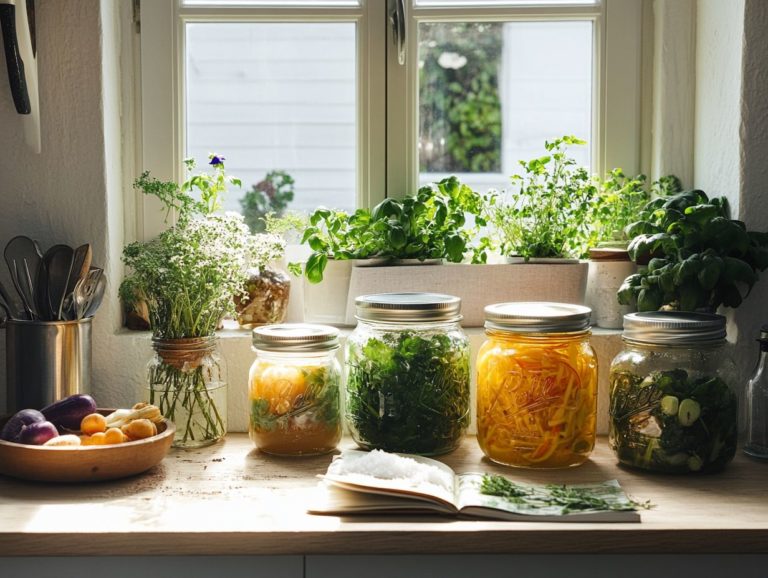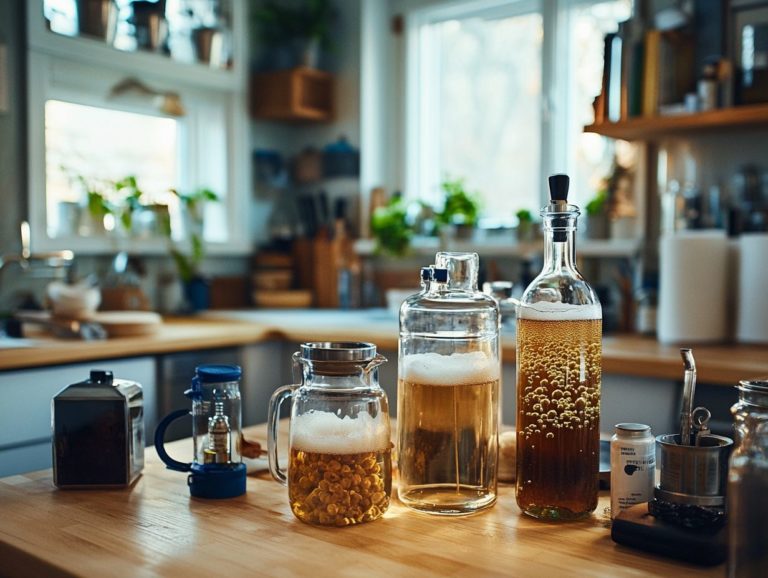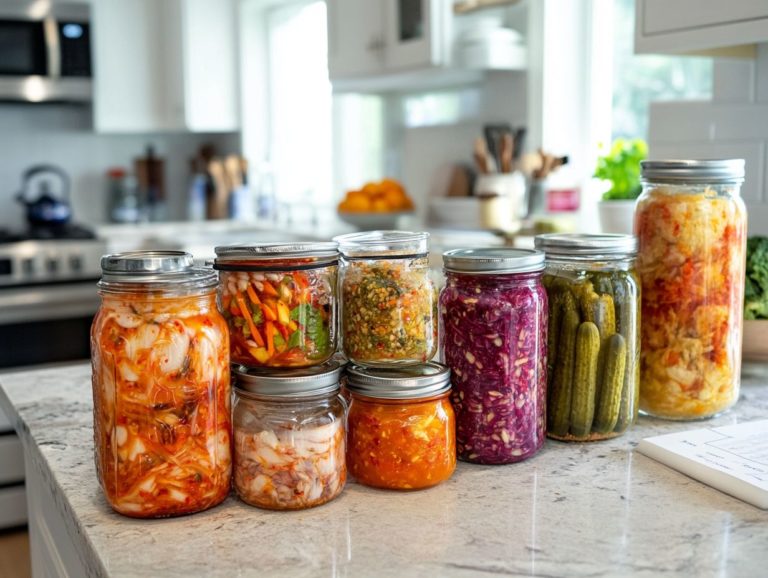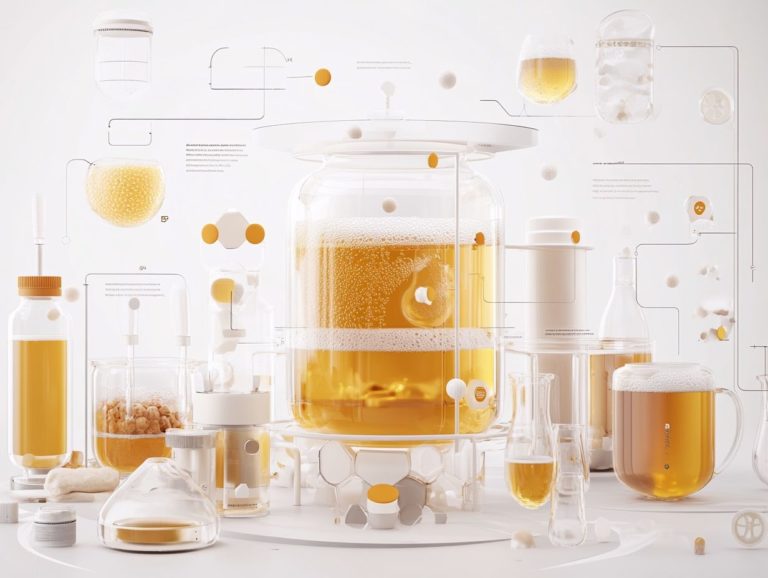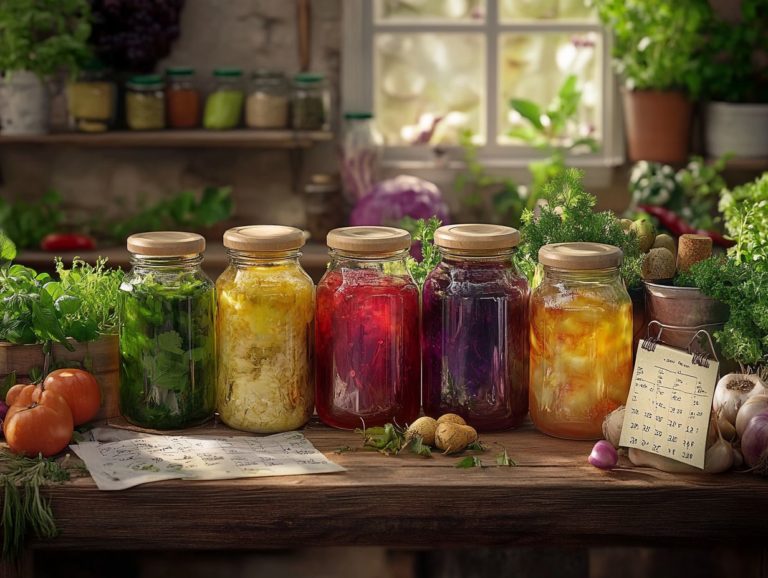How to Ferment Different Beer Types
Beer fermentation is a captivating process that takes simple ingredients and transforms them into a rich tapestry of beverages, each boasting its own unique flavor and character. This intricate fermentation process is part of the broader homebrewing process that many beer enthusiasts embrace.
When you grasp the various types of fermentation top-fermenting, bottom-fermenting, and spontaneous you lay the groundwork for mastering an impressive range of beer styles, from ales to lagers and stouts. This understanding highlights key differences between ale and lager fermentation.
You’ll discover that factors like fermentation temperature, yeast strain, and wort composition can greatly impact the final product, making temperature control a crucial aspect of the homebrewing process.
This article delves into fermentation techniques, the common challenges brewers encounter, and the solutions that will guide you toward a successful brewing adventure using high-quality brewing equipment and beer fermenters.
Contents
- Key Takeaways:
- What are the Different Types of Beer Fermentation?
- How to Ferment Different Beer Types?
- Lager
- Lambic
- Pilsner
- 5. Stout and Other Beer Styles
- What are the Factors that Affect the Fermentation Process?
- How to Monitor and Control the Fermentation Process?
- What are the Common Problems in Fermentation and How to Fix Them?
- Frequently Asked Questions
- What are the different beer types that can be fermented?
- What is the recommended temperature for fermenting different beer types?
- How long does it take to ferment different beer types?
- What type of yeast should be used for fermenting different beer types?
- Can different beer types be fermented using the same equipment?
- Are there any specific steps to follow when fermenting different beer types?
Key Takeaways:
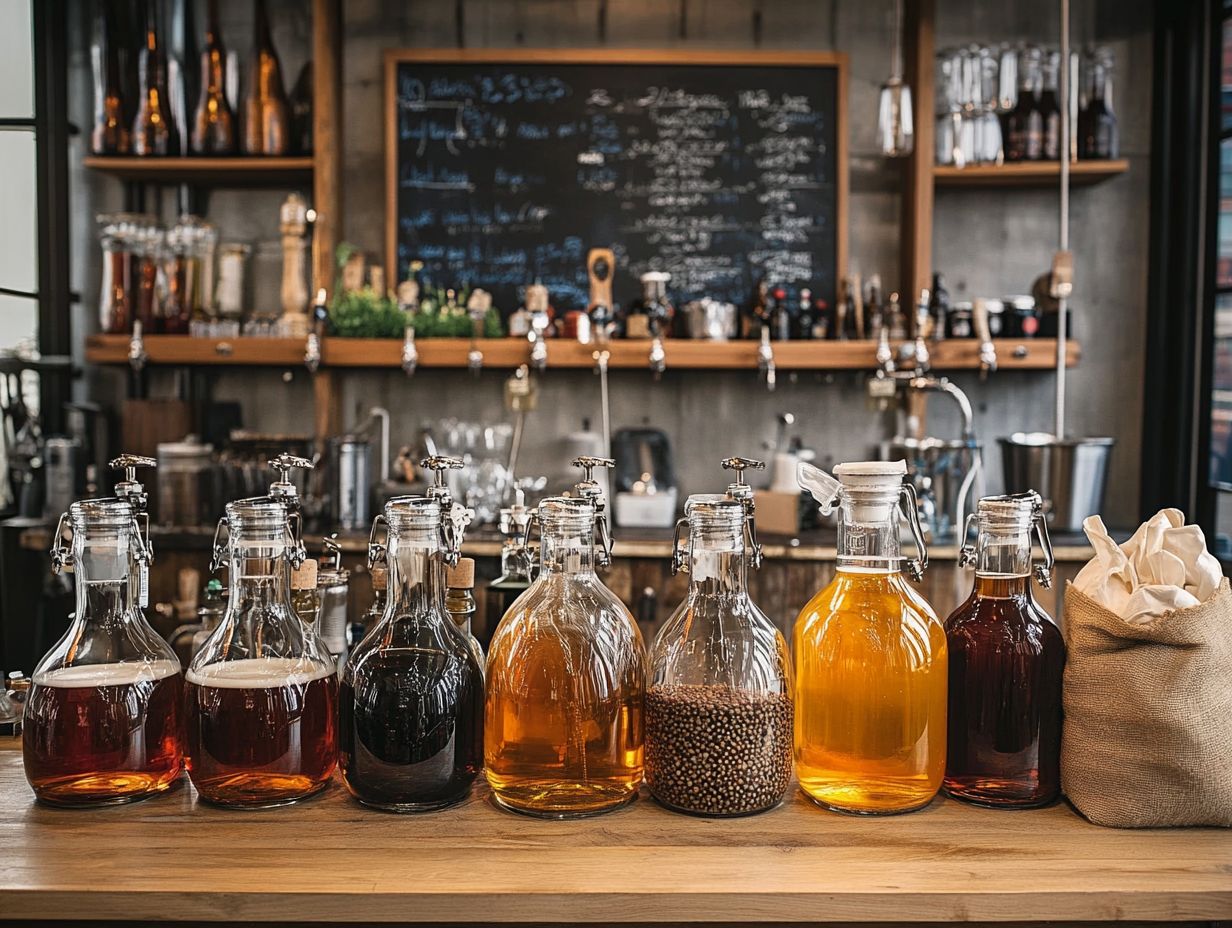
- Ale and lager are the two main types of beer fermentation, with top-fermenting yeast used for ale and bottom-fermenting yeast for lager. Understanding these ale lager differences is fundamental for any brewer.
- Temperature, yeast strain, oxygenation, and wort composition are all important factors that can affect the fermentation process and the final flavor of the beer. Each yeast strain brings its own exciting twist to the brewing process!
- Monitoring and controlling fermentation through the use of a hydrometer, adjusting temperature, oxygen levels, and adding nutrients can help prevent common problems such as stuck fermentation and off-flavors. This keeps the yeast healthy and helps you achieve your brewing goals.
What are the Different Types of Beer Fermentation?
Beer fermentation is a vital component of homebrewing, where the choice of yeast significantly influences the flavor, aroma, and overall quality of your brew. By understanding the different types of fermentation and the fermentation phases, you can elevate your brewing game.
For instance, top-fermenting yeast like Saccharomyces cerevisiae can create vibrant ales. In contrast, bottom-fermenting yeast, typical of lagers, brings a crisp finish. Spontaneous fermentation, often used for styles like Lambic, adds another layer of complexity to your brewing repertoire. Additionally, the use of specialty yeast strains like Kveik yeast can introduce unique flavors and speed up the fermentation process.
Each yeast strain has its own unique metabolism and temperature preferences. It also produces distinct byproducts such as esters, which are responsible for fruity flavors in beer, and fusels, which can add warmth. These fermentation byproducts contribute to the diverse array of beer styles that you can explore and enjoy.
Embracing this knowledge can truly enhance your brewing experience, allowing you to craft exceptional beers that reflect your personal tastes and brewing aspirations. Companies like White Labs and Yolong Brewtech offer resources and equipment to support your brewing journey.
1. Top-Fermenting Yeast
Top-fermenting yeast, particularly Saccharomyces cerevisiae, is a fundamental player in the creation of various ale styles. This yeast thrives in warmer fermentation temperatures, allowing for vigorous yeast activity that results in distinctive flavor profiles due to its unique enzymatic pathways.
You ll find that this yeast strain flourishes in conditions typically ranging from 60 to 78 degrees Fahrenheit, which is crucial for developing the complex aromatic qualities that set ales like Hefeweizen and Saison apart. Brewing experts such as Kara Taylor of White Labs and Neva Parker highlight that the elevated temperatures associated with top fermentation create an ideal environment for yeast to produce a rich array of esters and fusel alcohols.
These compounds not only impart the fruity and spicy notes that define these beers but can also introduce a subtle warmth, enhancing your overall tasting experience. Paying attention to yeast health and fermentation management is essential; it allows the yeast to fully express its potential in crafting these beloved styles of ale.
So, dive into your brewing adventure today and uncover flavors you never knew existed!
How to Ferment Different Beer Types?
To successfully ferment various types of beer, you must grasp the intricacies of the fermentation process, paying particular attention to the distinct requirements of ales and lagers. Each stage of the fermentation phases is crucial in achieving your brewing goals.
Each beer style demands specific fermentation temperatures and durations, factors that significantly impact the flavor and characteristics of the final product. Understanding these nuances will elevate your brewing experience and result in exceptional beer.
1. Ale
Ales are typically crafted with top-fermenting yeast, such as Saccharomyces cerevisiae, which thrives in warmer temperatures. This allows for a quicker fermentation process and the emergence of distinctive flavors, including delightful fruity esters and fusels.
This particular yeast flourishes in temperatures ranging from 60 F to 75 F, creating a vibrant fermentation atmosphere. Proper temperature control is paramount, as it impacts both the health of the yeast and the overall flavor profile of your ale.
High-quality malting barley and brewing equipment also play significant roles in achieving optimal results. By maintaining the right temperature, you can prevent unwanted off-flavors and ensure a vigorous fermentation.
Employing techniques like gradual temperature ramps can elevate the development of complex flavors, especially in styles like Hefeweizen, renowned for its enticing banana and clove notes. Similarly, Saisons capture farmhouse characteristics, boasting spicy and fruity notes that stem from both the yeast strain and the length of fermentation.
These ales typically benefit from a primary fermentation phase lasting one to two weeks, followed by a conditioning period that further polishes their flavors to perfection.
2. Bottom-Fermenting Yeast
Bottom-fermenting yeast is an essential element in the art of lager brewing, employing strains such as Saccharomyces pastorianus that flourish at cooler fermentation temperatures. This method leads to a remarkably clean taste profile and extends the fermentation process, elevating the quality of your brew through meticulous temperature control.
This distinctive fermentation technique is especially pivotal in crafting beloved styles like Pilsner and American Lager. Both of these styles are celebrated for their crisp and refreshing characteristics.
By fermenting at lower temperatures typically between 45 F and 55 F you slow down yeast metabolism, enabling a more controlled fermentation. This careful management minimizes the production of esters, which are compounds that can give beer fruity flavors, and phenols, which can contribute spicy notes.
As a result, your final product achieves a harmonious balance of malt sweetness and hop bitterness, embodying the clean and straightforward profiles that beer enthusiasts appreciate. Precise temperature control is essential for flavor development and is crucial for producing the light body and dry finish that define these exceptional lager styles.
3. Spontaneous Fermentation
Spontaneous fermentation is a captivating traditional brewing method, particularly utilized in crafting specialty beers like Lambic. Here, wild yeast strains and ambient microorganisms take the reins, naturally initiating fermentation and often resulting in a delightful tapestry of complex flavors and aromas.
This ancient technique boasts deep historical roots, especially in the Brussels region of Belgium, where it has been celebrated for centuries. Unlike the controlled fermentation methods that depend on cultivated yeast, spontaneous fermentation embraces a diverse array of microorganisms, presenting a broader spectrum of flavor profiles that can vary dramatically from batch to batch.
You ll find that factors such as fermentation temperature and duration play vital roles in shaping the final product. Higher temperatures might quicken the fermentation process, introducing vibrant fruity notes, while cooler conditions can yield more nuanced and layered characteristics.
This delightful unpredictability not only defines the essence of Lambic beers but also captures the unique terroir of the region from which they hail.
Lager
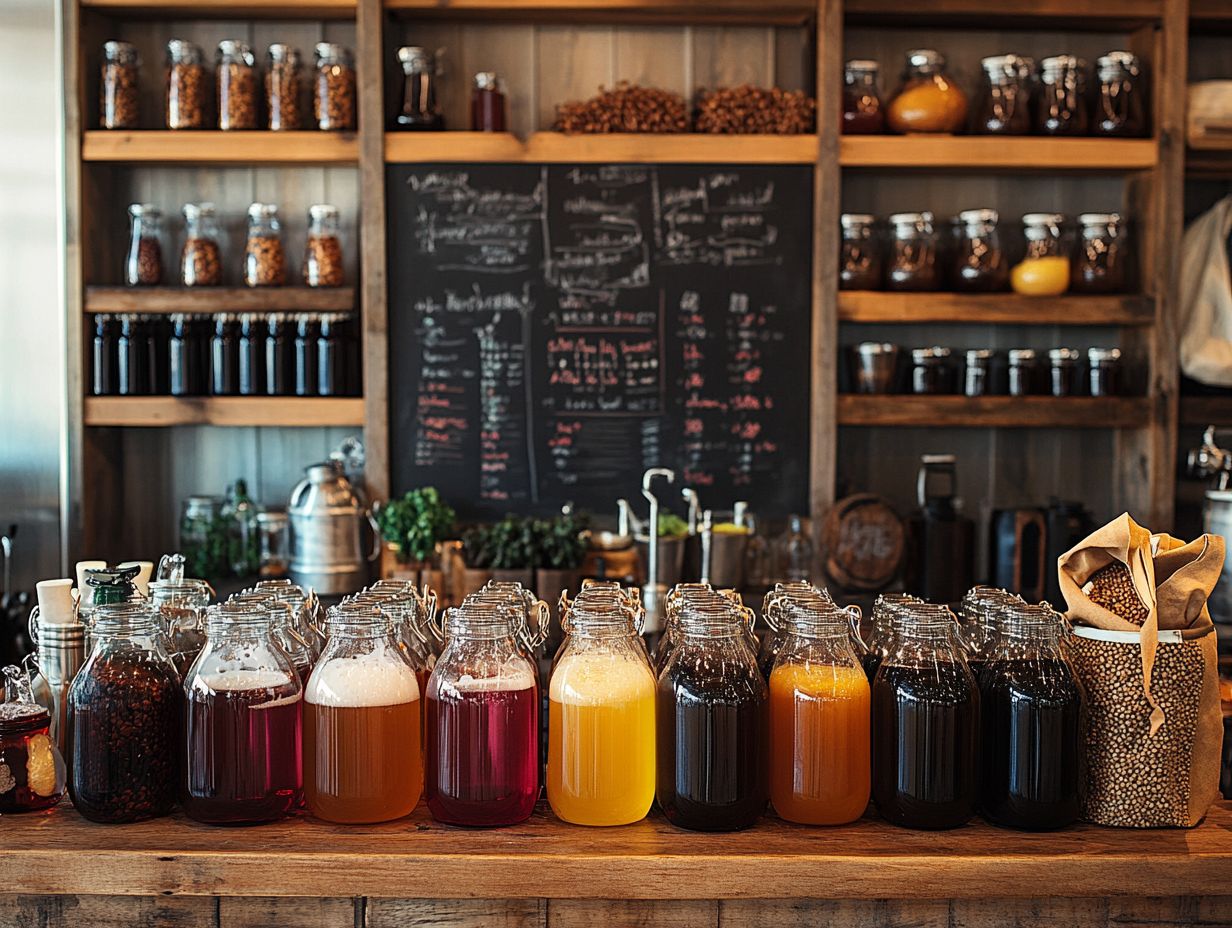
Lagers are crafted using yeast that ferments at the bottom, like Saccharomyces pastorianus, which thrive in cooler fermentation temperatures. This approach results in a longer fermentation process, yielding a crisp, clean flavor profile that sets them apart from ales.
Controlling fermentation temperature is essential, as it directly impacts how yeast works and the overall quality of the beer. By maintaining lower temperatures, typically between 45 F and 55 F, you can achieve a smooth, refined taste that brings out the best characteristics of various lager styles. Using the right brewing equipment is vital for success.
Yeast selection also plays a key role, as different strains contribute unique flavors and aromas that shape the final product. For instance, classic Pilsners present a delicate balance of malt sweetness and hop bitterness, whereas American Lagers tend to offer a more straightforward, refreshing profile.
When combined, these elements create distinct and enjoyable experiences for lager enthusiasts, making the most of the fermentation byproducts that define this beer style.
Lambic
Lambic is a thrilling beer style that excites with its spontaneous fermentation, drawing on the wild yeast and bacteria present in the environment to craft complex flavors and aromas. The outcome is often a tart and fruity brew that beautifully reflects its Belgian terroir.
This fascinating process usually involves a medley of wild yeasts, including Brettanomyces (a type of wild yeast), paired with various bacteria like Lactobacillus and Pediococcus, which contribute to the signature sourness and depth that defines this style. The fermentation temperature is crucial; warmer conditions can amplify fruity esters, while cooler temperatures tend to result in a drier, earthier profile. The unique enzymatic pathways of these microorganisms add to the exceptional character of Lambic beers.
Traditional brewing methods, such as using aged hops and open fermentation vessels, further enhance the exposure to ambient microorganisms, fostering an environment that encourages the development of unique character. Many Lambic beers also undergo extensive aging in wooden barrels, where the interaction with wood and oxidation deepens their complexity, yielding layered flavors that truly tantalize the palate. These techniques are pivotal in the homebrewing process.
Pilsner
Pilsner is a distinguished lager style that you ll recognize by its light color, crisp taste, and refreshing finish. This delightful profile is achieved through the use of bottom-fermenting yeast and meticulous temperature control during the fermentation process.
This brewing technique emphasizes the significance of maintaining a lower fermentation temperature, typically between 45-55 F (7-13 C), over several weeks. Using this cooler method allows yeast to work slowly and steadily, producing a clean, smooth flavor while minimizing any unwanted esters and phenols that might compromise the beer s crisp character.
Notable Pilsner brands, such as Pilsner Urquell and Stella Artois, exemplify this brewing mastery. Pilsner Urquell offers a rich, malty backbone that harmonizes beautifully with a hint of hop bitterness, while Stella Artois captivates with its lightness and floral aroma. Together, they showcase the remarkable versatility of this beloved lager style. Similar techniques are used in brewing American Lager and other international styles.
5. Stout and Other Beer Styles
Stout is a rich and dark ale style crafted with top-fermenting yeast, allowing for the emergence of deep roasted flavors and aromas, often elevated by specialty malts.
Your choice of yeast and fermentation temperature is pivotal in shaping the unique characteristics of each stout.
For instance, when you explore dry Irish stout, you’ll notice that it ferments at cooler temperatures, creating a crisp, clean finish that accentuates the roasted bitterness of the malt.
On the other hand, the luscious creaminess of a milk stout comes from the inclusion of lactose, which remains unfermented and imparts a delicate sweetness.
Different beer styles like Hefeweizen or Belgian ales also showcase the variety of flavors yeast can produce.
If you venture into variations like oatmeal stouts, you ll discover the silky mouthfeel that rolled oats provide.
Meanwhile, imperial stouts, with their higher alcohol content, showcase complex and warming flavors.
Exploring these elements will supercharge your brewing experience and deepen your love for this amazing beer style!
Understanding the brewing process and matching it with the right brewer s yeast can make a significant difference.
What are the Factors that Affect the Fermentation Process?
Numerous factors play a crucial role in shaping the fermentation process during brewing. You ll want to pay close attention to fermentation temperature, the selection of yeast strains, oxygenation levels, and the composition of the wort.
Each of these elements impacts the different fermentation phases and yeast activity, affecting the final product.
These factors influence everything from flavor to aroma.
1. Temperature
Fermentation temperature plays a pivotal role in yeast activity. It’s crucial to understand that different yeast strains have their own unique temperature ranges that can either elevate or inhibit the fermentation process.
By maintaining the ideal fermentation temperature, you can unlock a spectrum of flavors and aromas in your final product, resulting in distinctive beer profiles.
For instance, lager yeast flourishes at cooler temperatures, typically between 45 F and 55 F, which yields clean flavors and crisp profiles.
Fermentation temperature is also crucial when using specialized yeasts like Kveik yeast or Saison yeast, each with their unique requirements.
On the other hand, ale yeast thrives in warmer conditions, generally around 65 F to 75 F, leading to richer, fruity esters and complex phenolic compounds.
If temperatures soar beyond the optimal range, you risk developing undesirable byproducts like fusel alcohols, which can detract from the overall quality of your beer.
Thus, it s essential to diligently monitor and adjust temperatures throughout fermentation to achieve the specific characteristics you desire in your brews.
2. Yeast Strain
The choice of yeast strain is fundamental to the brewing process. Each strain comes with its own unique processes that yeast uses to convert sugars into alcohol and fermentation characteristics that significantly influence the flavor and aroma of your beer.
Traditional strains like Saccharomyces cerevisiae are often used to create popular styles like Hefeweizen and Pilsner.
Selecting the right yeast not only shapes the flavor profile but also plays a crucial role in determining the alcohol content and mouthfeel of your brew.
Factors like fermentation temperature are essential, as different strains thrive in specific thermal conditions.
For instance, lager yeasts typically prefer the cooler side of the spectrum, giving your beer a clean and crisp finish, while ale yeasts tend to thrive at warmer temperatures, leading to delightful fruity esters and interesting phenolic compounds.
Understanding the processes that yeast uses to convert sugars into alcohol can help optimize the brewing process.
Yeast activity will directly impact the fermentation duration; some strains are vigorous and race through the process, while others take their time, resulting in more complex flavors that develop over an extended period.
Ultimately, grasping these nuances enables you to create a beer that truly embodies your desired style.
3. Oxygenation
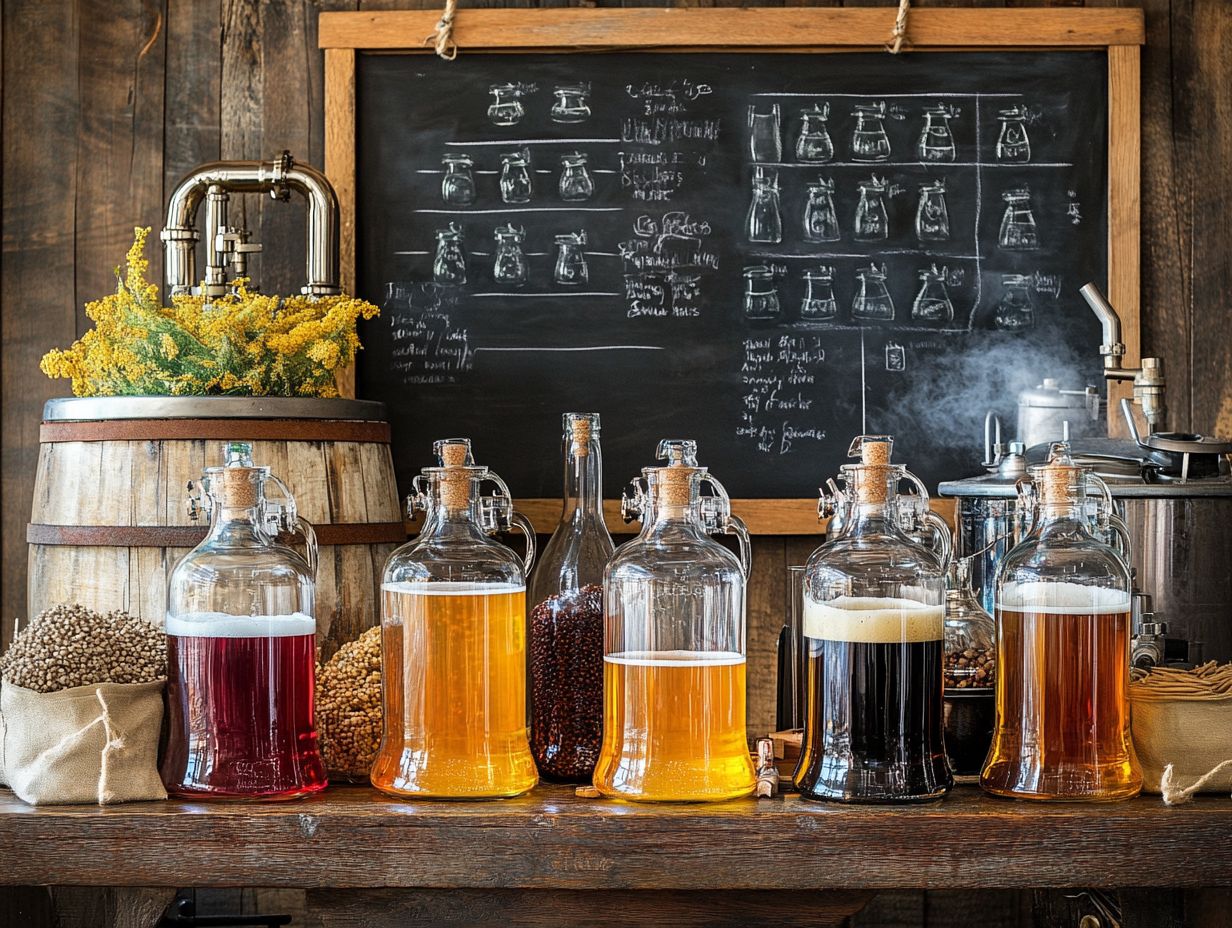
Oxygenation is vital for fermentation. It promotes healthy yeast metabolism, especially when yeast cells are rapidly reproducing.
By introducing the right amount of oxygen at this pivotal phase, you can effectively build yeast biomass. This ultimately leads to more vigorous fermentation. You can use several methods for oxygenation, such as shaking the wort, using an aeration stone, or directly incorporating oxygen with a gas line.
However, it s essential to monitor this process closely. Excessive oxygen exposure during fermentation can result in off-flavors and undesirable fermentation byproducts. Striking the right balance in oxygen levels is key to ensuring that the yeast performs at its best and preserves the integrity of your brew.
This balance will ultimately deliver a cleaner taste with higher fermentation efficiency.
4. Wort Composition and Fermentation Types
The composition of the wort is crucial in the fermentation journey. It offers the essential sugars and nutrients that yeast relies on to work its magic.
This foundation significantly influences the overall quality and flavor of the beer you create. Different types of malting barley introduce unique sugar profiles and enzymatic activities, leading to diverse fermentation dynamics.
For example, certain malts can enhance the production of specific fermentable sugars. Meanwhile, adjuncts like corn or rice may dilute the wort’s richness and potentially shorten fermentation times.
It’s essential to balance these elements to manage your brewing goals effectively. The balance between complex carbohydrates and simple sugars plays a vital role in determining the yeast s food sources.
This balance ultimately results in a variety of byproducts that shape the aroma and taste of your beer. Therefore, even minor adjustments in the wort’s composition can lead to significant changes in fermentation duration.
These adjustments allow you to craft unique beer styles with intricate flavors and textures.
How to Monitor and Control the Fermentation Process?
Monitoring and controlling fermentation is essential for achieving the quality of beer you desire. Utilize tools like a hydrometer to track specific gravity, which measures the density of the liquid.
This measurement helps you gauge how much sugar has been converted into alcohol, allowing you to accurately track the progress of your brew. Additionally, using professional-grade brewing equipment from suppliers like Yolong Brewtech can further enhance your brewing precision.
Using temperature control techniques will help maintain optimal yeast activity throughout the fermentation process. This ensures that each batch reflects your meticulous craftsmanship.
1. Using a Hydrometer
A hydrometer is an essential tool for monitoring fermentation. It enables you to measure specific gravity and assess the progress of fermentation.
By closely observing specific gravity readings at various stages, you gain invaluable insights into how sugars are being converted into alcohol. This data acts as a roadmap, guiding you to determine whether fermentation is progressing as anticipated or if adjustments are needed.
Insights from experts like Kara Taylor and Neva Parker of White Labs can be particularly beneficial in understanding these nuances. If you notice minimal changes in the readings over several days, it may signal that the yeast is underperforming.
This underperformance could be due to temperature fluctuations or nutrient deficiencies. By accurately interpreting these figures, you can make timely adjustments, such as modifying the temperature or adding nutrients.
These actions ensure that your fermentation process remains both successful and efficient.
What are the Common Problems in Fermentation and How to Fix Them?
Common issues during fermentation types like stuck fermentation, off-flavors, and infections can seriously affect the quality of your beer. With diligent monitoring and timely adjustments, you have the power to tackle these challenges head-on and elevate your brewing experience.
1. Stuck Fermentation
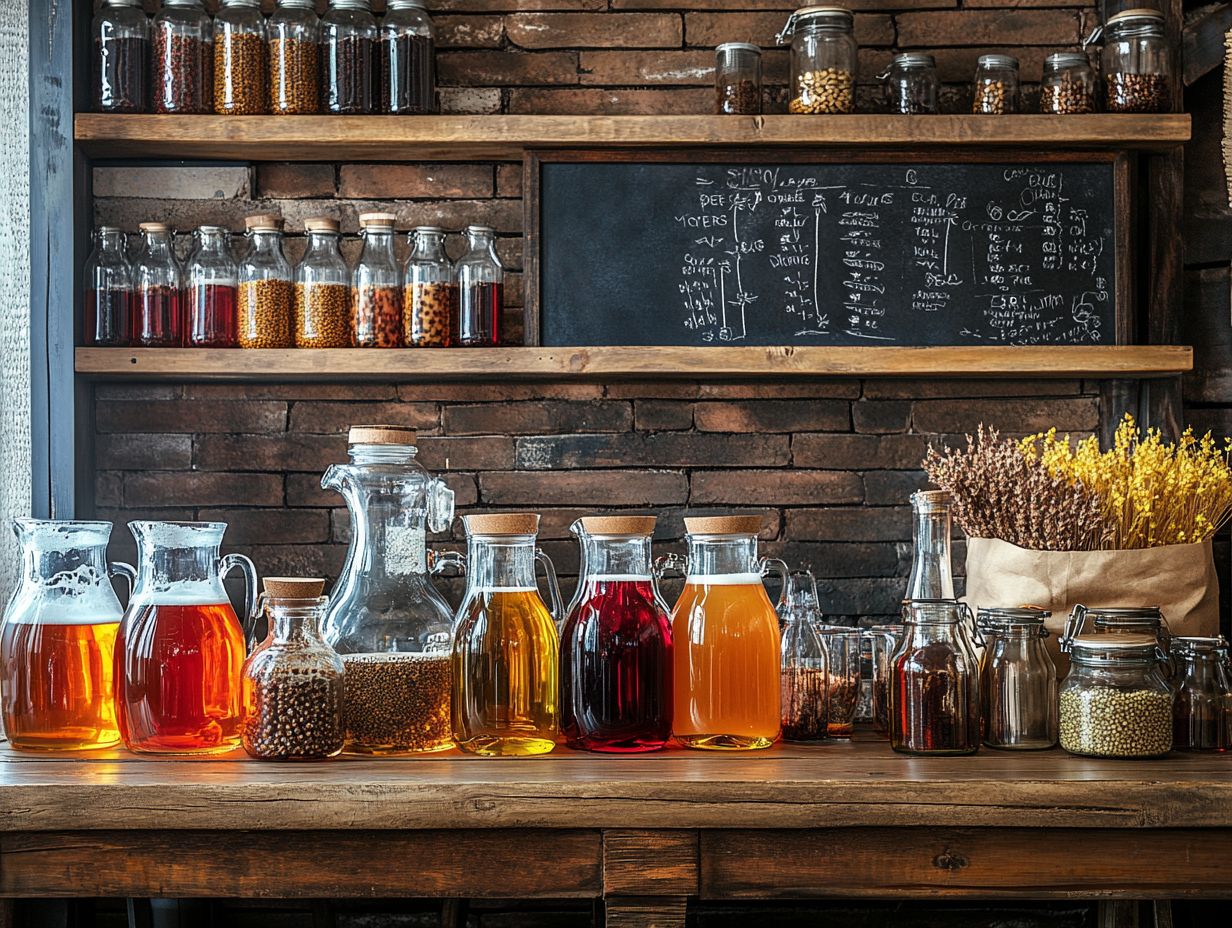
Stuck fermentation happens when yeast activity grinds to a halt prematurely, often due to insufficient nutrients, low temperatures, or inadequate oxygen levels, which results in leftover sugars that can make your beer taste sweet and unfinished.
This situation can be particularly frustrating for you as a brewer, especially after investing time and resources into your craft. The result is a sweet, unfinished product that fails to deliver the flavor profile you intended.
When you encounter this challenge, there are several practical steps you can take to revive yeast activity:
- Gently raising the temperature can stimulate yeast metabolism and get things moving again.
- Adding essential nutrients provides the necessary compounds for healthy fermentation, giving your yeast the boost it needs.
- In some cases, carefully stirring the fermentation vessel to introduce oxygen can rekindle yeast vigor, allowing them to resume their crucial work of converting sugars into alcohol.
2. Adjusting Temperature and Oxygen Levels
Adjusting temperature and oxygen levels is vital during fermentation, as maintaining optimal conditions can significantly enhance yeast activity and overall fermentation efficiency.
For you as a brewer, grasping the intricacies of fermentation temperature is essential. By skillfully controlling the temperature, you can elevate yeast performance, encouraging ideal production of the flavors and aromas you desire.
While higher temperatures may speed up fermentation, they might also produce unwanted esters and fusels, which can compromise your final product. Conversely, managing oxygen levels during this phase of the homebrewing process is crucial; excessive oxygen can lead to spoiling, while insufficient oxygen can undermine yeast activity.
Employing strategies such as temperature monitoring systems and oxygenation techniques will help you keep the fermentation process on track, ultimately resulting in cleaner and more refined beer profiles, free from off-flavors.
3. Adding Nutrients or Enzymes in Different Fermentation Phases
By adding nutrients or enzymes to your fermentation process, you enhance yeast metabolism and overall fermentation efficiency. This vital step not only sustains yeast vitality but also optimizes both flavor development and alcohol production key factors in achieving the desired characteristics for various beer styles.
Different beer styles call for specific nutrient profiles; for instance, lagers often benefit from amino acids and phosphates, while ales thrive on a higher concentration of nitrogen-rich compounds. Incorporating these nutrients at the right stages of fermentation phases can prevent sluggishness and off-flavors, allowing your yeast to perform at its peak.
Certain enzymes, which are substances that help break down sugars, can also enhance fermentability and contribute to a cleaner finish. Understanding the unique requirements of each style and properly integrating these essential elements into your brewing process can significantly elevate the quality of your final product.
2. Off-Flavors
Off-flavors in beer can stem from a variety of factors during the process of brewing beer, such as stressed yeast, elevated fermentation temperatures, or even infections. These issues can lead to undesirable taste profiles.
These off-flavors can significantly diminish your overall sensory experience, making it crucial to grasp the underlying causes. Common pitfalls, like wild yeast contamination or insufficient oxygen levels, can worsen these flavors, resulting in everything from unwanted sourness to overly fruity esters.
Adopting rigorous sanitation practices is essential to address these concerns. Ensure that all your brewing equipment is meticulously cleaned and sanitized before use. Maintaining optimal fermentation temperatures and closely monitoring yeast health can prevent stress and promote a clean fermentation profile, ultimately allowing the true character of your beer to shine through.
3. Infection
Infection during fermentation can lead to unexpected sourness or off-aromas, often caused by wild bacteria or yeast strains. This underscores the importance of strict sanitation and proper handling throughout the brewing process.
Recognizing the signs of infection is crucial, as they can show up in taste inconsistencies, unusual odors, or visible changes in your brew. These indicators can significantly affect the quality of your final product, so stay alert to catch any signs of infection early!
To mitigate these risks, it is vital to implement rigorous sanitation practices. This means thoroughly cleaning your equipment, using sanitized water, and maintaining a controlled fermentation environment. By consistently monitoring the process, you can catch any contamination early, allowing you to take timely action to safeguard your efforts and preserve the integrity of your creations.
Watch this video to better understand common off-flavors in beer:
Frequently Asked Questions
What are the different beer types that can be fermented?
Some examples of beer types that can be fermented include lagers, ales, stouts, porters, wheat beers, and sour beers.
What is the recommended temperature for fermenting different beer types?
The recommended fermentation temperature for most beer types is between 60-75 F. However, some beer styles may require specific temperatures for optimal results.
How long does it take to ferment different beer types?
The fermentation duration for different beer types can vary, typically ranging from 1-2 weeks for ales and up to 2-4 weeks for lagers. Sour beers and high ABV beers may require longer fermentation times.
What type of yeast should be used for fermenting different beer types?
The type of yeast used for fermenting different beer types can vary, but commonly used strains include brewer s yeast, ale yeast, lager yeast, and wild yeast for sour beers.
Can different beer types be fermented using the same equipment?
Yes, the same equipment can be used for fermenting different beer types. However, it is recommended to thoroughly clean and sanitize the beer fermenters between batches to avoid any cross-contamination of flavors.
Are there any specific steps to follow when fermenting different beer types?
Yes, the basic steps for fermenting different beer types include creating a clean and sanitized environment, pitching the yeast, monitoring the fermentation temperature, and transferring the beer to a secondary fermenter if desired.

